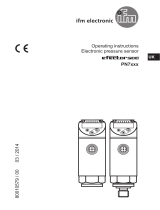1716
UK
9.3 User settings (optional)
9.3.1 Set delay for the switching outputs
• [dS1] = time delay for SP1 / FH1. If the system pressure exceeds SP1 or
if the system pressure enters the acceptable range (window), the output
changes the switching status when the time dS1 has elapsed.
• [dr1] = time delay for rP1 / FL1. If the system pressure falls below rP1 or
if the system pressure leaves the acceptable range (window), the output
changes the switching status when the time dr1 has elapsed.
►Select [dS1] or [dr1] and set the value between 0 and 5000 ms in steps
of 2 ms (at 0 the time delay is not active).
9.3.2 Set damping for the switching outputs
►Select [dAP] and set the value.
dAP value = response time between pressure change and change of the
switching status in milliseconds.
The following fixed values can be set; they define the switching frequency (f
in Hz) of the output:
dAP 6 10 30 60 100 250 500 1000 2000
f 80 50 16 8 5 2 1 0.5 0.25
9.3.3 Configuration of the display
►Select [diS] and set the update rate and orientation of the display:
- [d1]: update of the measured values every 50 ms.
- [d2]: update of the measured values every 200 ms.
- [d3]: update of the measured values every 600 ms.
- [Ph]: display of the pressure peaks remains for a short time (peak
hold).
- [rd1], [rd2], [rd3], [rPh]: display as for d1, d2, d3; rotated by 180°.
- [OFF]: the display is switched off in the operating mode.
►Select [cLor] and define the colour of the digital display:
- [r-on]: display = red if output 1 is switched; display = green if output 1
is not switched.
- [G-on]: display = green if output 1 is switched; display = red if output 1
is not switched.
- [red]: the colour of the display is red / does not change.
- [Gren]: the colour of the display is green / does not change.
9.3.4 Zero-point calibration
►Select [coF] and set a value between -2 % and 2 % of the measuring
span. The internal measured value "0" is shifted by this value.
As an alternative: Automatic adjustment of the offset in the range 0 bar ± 2
% of the measuring span.
►Make sure that there is no system pressure or that there is a differential
pressure of 0 bar or that it is as close as possible to the 0 bar mark.
►Press [Mode/Enter] until [tcoF] appears.
►Press [Set] and keep it pressed.
> The current offset value (in %) flashes briefly.
►Release [Set].
►Briefly press [Mode/Enter] (= to confirm the new offset value).
Reset of the taught value:
►Select [coF] and set the value [0].
9.3.5 Differential pressure measurement: optimisation of the sensor
accuracy
During differential pressure measurement the sensor accuracy can be
optimised: An average system pressure value is entered that is close to the
operating pressure on the main connection (G1/8):
►Select [SySP] and then briefly press [Set].
> The currently set value is displayed.
►Press [Set] and keep it pressed.
> After 5 s: The average system pressure value can be set in the range
of 0...+10 bar and in steps of 0.2 bar (unit depending on the setting of
[uni]).
►Briefly press [Mode/Enter].
> The new set value is confirmed.
9.4 Service functions
9.4.1 Read min/max values for the system pressure
►Select [Hi] or [Lo], briefly press [Set].
[Hi] = maximum value, [Lo] = minimum value.
Delete memory:
►Select [Hi] or [Lo].
►Press [Set] and keep it pressed until [----] is displayed.
►Briefly press [Mode/Enter].











